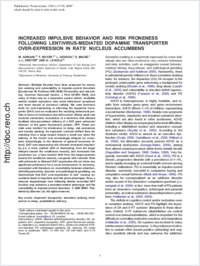Increased impulsive behavior and risk proneness following lentivirus-mediated dopamine transporter over-expression in rats' nucleus accumbens
- Adriani, W. Behavioral Neuroscience Section, Department of Cell Biology and Neurosciences, Istituto Superiore di Sanità, Roma, Italy
- Boyer, Frederic Department of Medicine, University of Fribourg, Switzerland
- Gioiosa, L. Behavioral Neuroscience Section, Department of Cell Biology and Neurosciences, Istituto Superiore di Sanità, Roma, Italy
- Macrì, S. Behavioral Neuroscience Section, Department of Cell Biology and Neurosciences, Istituto Superiore di Sanità, Roma, Italy
- Dreyer, Jean-Luc Department of Medicine, University of Fribourg, Switzerland
- Laviola, G. Behavioral Neuroscience Section, Department of Cell Biology and Neurosciences, Istituto Superiore di Sanità, Roma, Italy
-
07.12.2008
Published in:
- Neuroscience. - 2009, vol. 159, no. 1, p. 47-58
English
Multiple theories have been proposed for sensation seeking and vulnerability to impulse-control disorders [Zuckerman M, Kuhlman DM (2000) Personality and risk-taking: Common biosocial factors. J Pers 68:999–1029], and many of these rely on a dopamine system deficit. Available animal models reproduce only some behavioral symptoms and seem devoid of construct validity. We used lentivirus tools for over-expressing or silencing the dopamine transporter (DAT) and we evaluated the resulting behavioral profiles in terms of motivation and self-control. Wistar adult rats received stereotaxic inoculation of a lentivirus that allowed localized intra-accumbens delivery of a DAT gene enhancer/silencer, or the green fluorescent protein, GFP. These animals were studied for intolerance to delay, risk proneness and novelty seeking. As expected, controls shifted their demanding from a large reward toward a small one when the delivery of the former was increasingly delayed (or uncertain). Interestingly, in the absence of general locomotor effects, DAT over-expressing rats showed increased impulsivity (i.e. a more marked shift of demanding from the large/delayed toward the small/soon reward), and increased risk proneness (i.e. a less marked shift from the large/uncertain toward the small/sure reward), compared with controls. Rats with enhanced or silenced DAT expression did not show any significant preference for a novel environment. In summary, consistent with literature on comorbidity between attention-deficit/hyperactivity disorder and pathological gambling, we demonstrate that DAT over-expression in rats' nucleus accumbens leads to impulsive and risk prone phenotype. Thus, a reduced dopaminergic tone following altered accumbal DAT function may subserve a sensation-seeker phenotype and the vulnerability to impulse-control disorders.
- Faculty
- Faculté des sciences et de médecine
- Department
- Département de Médecine
- Language
-
- English
- Classification
- Biological sciences
- License
-
License undefined
- Identifiers
-
- RERO DOC 12514
- DOI 10.1016/j.neuroscience.2008.11.042
- Persistent URL
- https://folia.unifr.ch/unifr/documents/301434
Statistics
Document views: 123
File downloads:
- pdf: 328
